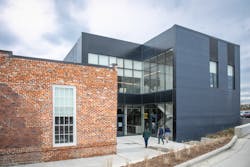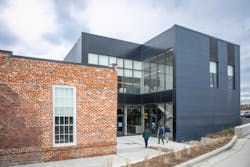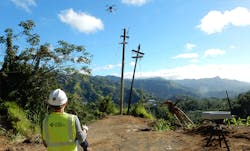1904. The year Duke Energy was founded. More than 100 years ago.
At that time, the thought of drones, artificial intelligence, machine learning, renewable energy, and virtual reality would have sounded like gibberish, rather than innovative options to operate a utility.
Fast forward to 2020. Once considered primarily asset operators, utilities have had to look within and consider how they change their culture — their DNA — to keep pace with the rapidly changing external environment and technology trends. The standard utility model and baseload generation infrastructure has drastically evolved, and customer expectations have challenged energy companies to invest in two-way communications channels.
Over the past decade, utilities have become more agile, innovative, and collaborative. With growing digital capabilities, regulatory change, and increasing calls for cleaner energy, utilities must rely on those same traits to meet customers’ changing needs, tackle operational inefficiencies and develop new products and services.
Duke Energy is going digital
Recognizing the need for digital transformation in this new era, Duke Energy launched Lighthouse, an employee-driven digital transformation program in 2018, to unlock and accelerate innovative ideas and solutions across the enterprise.
To support this work, the company transformed a 100-year-old mill in Charlotte, North Carolina, into an innovation hub dedicated to creativity, innovation and ideation. In this space, more than 400 cross-functional teammates collaborate and embrace new technologies and design-thinking to prioritize digital initiatives, challenge the status quo and create smart solutions for customers.
While Duke Energy’s innovation journey dates back to its inception, Lighthouse is fueling a new transformation that positions the company to become one of the first true digital utilities.
Drones are transforming inspections and power restoration
The advent of new technologies is enabling Duke Energy to chart a new path in the industry. And, it’s beyond just the traditional technology department — digital capabilities and data analytics are beginning to permeate every corner of the company.
By using drones, the company is reducing safety hazards for employees and transforming operations — including infrastructure and asset inspections.
Manual electrical testing at solar plants, power poles and substations can be dangerous and time consuming. At a solar site, a technician must walk the solar panels with a handheld thermal device to inspect equipment. Now, Duke Energy is equipping drones with infrared cameras to examine equipment with thermal imaging. Within seconds, a technician can identify faulty equipment and schedule maintenance accordingly.
As tasks become more complex, the company is finding even more ways to use drone technology. In 2018, Duke Energy drone operators engineered a breakthrough magnetic release device that enables a drone to string leader line — which is used on transmission and distribution lines to carry energy to customers. Following Hurricane Maria, the team used this device to string 9,000 feet of line to connect distribution poles in Puerto Rico. Without this device, crews would have had to use a helicopter or shoot lines across ravines and climb through the stark mountains to rebuild the grid. This was the first time a utility had performed work like this — which continues across Duke Energy’s Southeast and Midwest service areas today.
Leveraging robotics, data and machine learning to be more efficient and effective
Keeping the power on is Duke Energy’s number one priority — and technology is making that easier. The company is leveraging data from drones, sensors, smart meters and more to inform operational decisions, maintenance schedules and customer needs.
It starts with the generation of power. The company installed vibration monitors on some of its turbine blades at coal and natural gas plants to detect issues in real-time. The data captured enables predictive maintenance work, freeing technicians from sometimes unnecessary routine labor, and allows Duke Energy to more strategically plan and invest for the future.
And, beyond generation sites, the company’s focused on maintaining vegetation near its power lines. Understanding the need for more data into regional vegetation, Duke Energy began using light detection and ranging (LiDAR) sensors.
LiDAR scans alone are driving actionable intelligence. This insight alerts crews to hazards like ravines that might be hidden by overgrowth, enables more precise and efficient removal to preserve healthy trees and serves as a detailed map for drone and helicopter pilots when navigating terrain.
Duke Energy is then fusing their data with artificial intelligence and machine learning to perform predictive analysis of vegetation growth, calculate vegetation risk scores and optimize work schedules.
Advancing digital during a pandemic
The Lighthouse operating model also works beyond the walls of the company’s brick-and-mortar innovation hub. During the COVID-19 pandemic, employees working remotely engineered a COVID-19 tracking tool that could collect and aggregate virus case data.
Using the Lighthouse approach to product development — build in small increments then measure, learn and iterate — the team created the tracker tool in only nine days. The tool rivaled similar products in the market being prototyped and sold across many industries — and the Duke Energy team provided the company with an effective tool to track cases reported by teammates in record time.
The tool is still in operation today and has allowed the company to maintain a focus on health and safety of its employees.
So, in reflecting on the utility of 2020 — times look a bit different. Drones, data analytics, machine learning and artificial intelligence — these are no longer gibberish, but rather fundamentals that are catapulting Duke Energy to the forefront of the sector’s digital transformation.
With its dedicated Lighthouse program and renewed DNA rooted in digital, Duke Energy’s innovation journey is well underway — ensuring the future is bright for its customers and communities.
About the Author
Richard Donaldson
Richard Donaldson is Vice President, Digital Transformation at Duke Energy.






